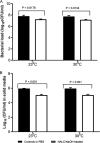Molecular Bacterial Load Assay Concurs with Culture on NaOH-Induced Loss of Mycobacterium tuberculosis Viability
- PMID: 31018981
- PMCID: PMC6595441
- DOI: 10.1128/JCM.01992-18
Molecular Bacterial Load Assay Concurs with Culture on NaOH-Induced Loss of Mycobacterium tuberculosis Viability
Abstract
Effective methods to detect viable Mycobacterium tuberculosis, the main causative agent of tuberculosis (TB), are urgently needed. To date, cultivation of M. tuberculosis is the gold standard, which depends on initial sample processing with N-acetyl-l-cysteine-sodium hydroxide (NALC-NaOH), chemicals that compromise M. tuberculosis viability and, consequently, the performance of downstream tests. We applied culture and the novel molecular bacterial load assay (MBLA) to measure the loss of M. tuberculosis viability following NALC-NaOH treatment of M. tuberculosis H37Rv pure culture and clinical sputum samples from pulmonary TB patients. Compared to the bacterial loads of untreated controls, NALC-NaOH treatment of M. tuberculosis reduced the MBLA-detectable bacillary load (estimated number of CFU [eCFU] per milliliter) by 0.66 ± 0.21 log10 at 23°C (P = 0.018) and 0.72 ± 0.08 log10 at 30°C (P = 0.013). Likewise, NALC-NaOH treatment reduced the viable count on solid culture by 0.84 ± 0.02 log10 CFU/ml at 23°C (P < 0.001) and 0.85 ± 0.01 log10 CFU/ml at 30°C (P < 0.001), respectively. The reduction in the viable count was reflected by a corresponding increase in the time to positivity of the mycobacterial growth indicator tube (MGIT) liquid culture: 1.2 days at 23°C (P < 0.001) and 1.1 days at 30°C (P < 0.001). This NaOH-induced M. tuberculosis viability loss was replicated in clinical sputum samples, with the bacterial load dropping by 0.65 ± 0.17 log10 from 5.36 ± 0.24 log10 eCFU/ml to 4.71 ± 0.16 log10 eCFU/ml for untreated and treated sputa, respectively. Applying the model of Bowness et al. (R. Bowness, M. J. Boeree, R. Aarnoutse, R. Dawson, et al., J Antimicrob Chemother 70:448-455, 2015, https://doi.org/10.1093/jac/dku415) revealed that the treated MGIT time to culture positivity of 142 ± 7.02 h was equivalent to 4.86 ± 0.28 log10 CFU, consistent with the MBLA-measured bacterial load. Our study confirms the contribution of NALC-NaOH treatment to the loss of viable bacterial counts. Tests that obviate the need for decontamination may offer an alternative option for the accurate detection of viable M. tuberculosis and treatment response monitoring.
Keywords: Mycobacterium tuberculosis; NALC-NaOH; culture; decontamination; molecular bacterial load assay; sputum.
Copyright © 2019 American Society for Microbiology.
Figures




References
-
- World Health Organization. 2018. Global tuberculosis report. World Health Organization, Geneva, Switzerland.
Publication types
MeSH terms
Substances
LinkOut - more resources
Full Text Sources
Medical
Molecular Biology Databases

